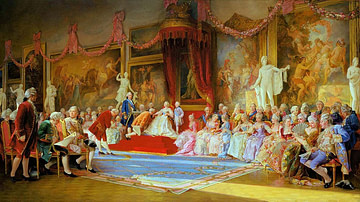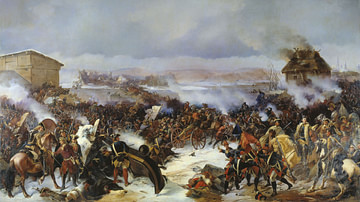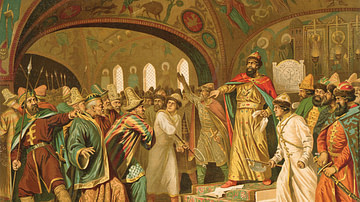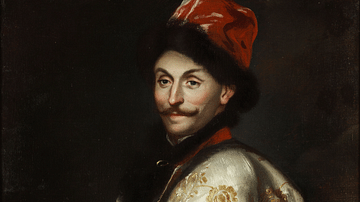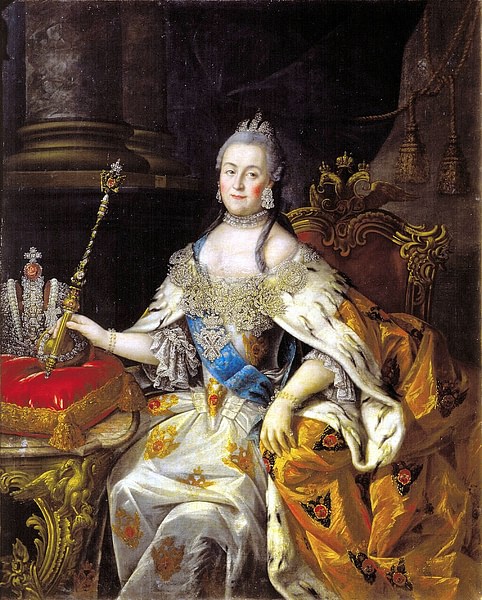
Catherine II of Russia (Catherine the Great) was empress regent of Russia from 1762-1796. She was born in Prussia to Prince Christian August of Anhalt-Zerbst (1690-1747) and Princess Johanna Elisabeth of Holstein-Gottorp (1712-1760), and although her family was noble, they were not wealthy. She married the future Russian Tsar, Peter of Holstein-Gottorp (1728-1762), in 1745 in St. Petersburg.
Peter was crowned Emperor Peter III of Russia in 1762, with Catherine becoming empress consort. However, Peter and Catherine's marriage and joint reign were not happy, and Catherine grew to hate all that Peter stood for. It was not long before Catherine began seeking support elsewhere and sought to overthrow Peter. With the Russian army's and her supporters' help, Peter was arrested and forced to sign an abdication form. He was assassinated a short time after, paving the way for Catherine to become the sole ruler of Russia.
Catherine was formally crowned empress regent on 22 September 1762, as Catherine II of Russia. During her lengthy reign, she transformed Russia's education system, the arts and the Russian economy and ushered in the age of the Russian Enlightenment.
Early Life
Catherine was born Sophie Friederike Auguste von Anhalt-Zerbst-Dornburg on 2 May 1729 in Stettin, Prussia (modern-day Szczecin, Poland), to Christian August, Prince of Anhalt-Zerbst and Princess Johanna Elisabeth of Holstein-Gottorp. She had two younger brothers and a younger sister. One of her younger brothers, Wilhem Christian, died at 12 from scarlet fever. Catherine was said to have had a closer relationship with her father than her mother.
Although they did not have much money, Catherine was educated by French tutors and a French governess, as was befitting a child of noble birth. Her governess, Elizabeth (Babet) Cardel, greatly influenced her, with Catherine referring to Elizabeth as the kind of governess that every child should have. Catherine was a happy child with a lot of energy. She played games with the local children and enjoyed taking command. Her childhood was relatively uneventful, with Catherine stating there was "nothing of interest in it."
Hopes of a Royal Marriage
Although she had three healthy children and lived in a castle, Johanna was not satisfied with her lot in life and regretted marrying a man who was beneath her status. She began visiting her well-connected relatives, taking Catherine with her when she was old enough. Johanna had one goal – to secure a royal marriage for her daughter.
In 1739, a 10-year-old Catherine met the 11-year-old future Peter III (then known as Charles Peter Ulrich, the Duke of Holstein). As the heir to the throne of Sweden and the only living grandson of Peter the Great of Russia, he was instantly considered an excellent match for Catherine, and Johanna was pleased to see her daughter reacting positively to him. In her memoirs, Catherine wrote that Peter was agreeable and well-bred. In reality, Peter was physically and emotionally undeveloped.
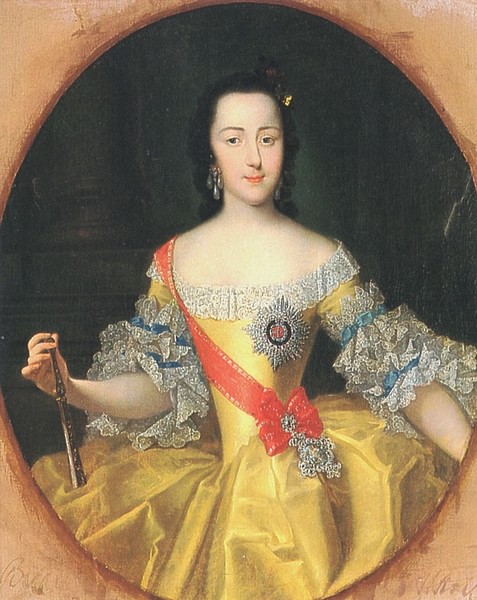
Catherine had a brief, innocent relationship with her uncle George Lewis, who asked for her hand in marriage. She accepted, but her parents wanted more for their daughter, and their relationship went no further. Johanna had familial connections to the Romanovs of Russia. The Russian Empress Elizabeth's older sister, Anne, was married to Johanna's cousin, Charles Frederick (the parents of Peter). Elizabeth had also been betrothed to Johanna's older brother, who had died before their wedding. Elizabeth regarded the house of Holstein with great fondness, which was incredibly advantageous for Catherine and her family. To further encourage this friendly relationship, Johanna took Catherine to the Prussian court painter Antoine Pesne, where she had her portrait painted to be sent as a gift to the empress.
In January 1742, Peter was named Elizabeth's heir, and Johanna's brother, Adolphus Frederick, became the heir to the Swedish throne in his place. On New Year's Day, 1744, an invitation from Russia arrived for Johanna and Catherine, followed by a letter from King Frederick II of Prussia, who expressed his wishes for Catherine to become the wife of Peter. On 10 January 1744, Catherine and her parents were on their way to meet King Frederick II in Berlin, as Frederick II was to approve of Catherine before she went to Russia.
Arrival in Russia
Catherine and her mother travelled to Russia in a procession of four carriages on 16 January 1744. They arrived at the Winter Palace on 3 February 1744, where they were given an imperial welcome. They finally met with Peter and Empress Elizabeth on 9 February 1744. Although Peter was genuinely glad to see Catherine, it was clear that he regarded her more as a friend than his future wife. Catherine was disappointed but determined to face anything that was thrown her way.
Catherine soon began her Russian education. A professor taught her how to speak and write in Russian, while a priest gave her lessons on the Russian Orthodox Church. She loved Russia and was so dedicated to her studies that she would wake up in the middle of the night to recite Russian words. These late-night lessons caused her to catch pneumonia, and she became gravely ill. Empress Elizabeth rushed to her bedside and helped nurse her back to health.

Marriage to Peter III
Catherine entered the Russian Orthodox Church on 28 June 1744, with her formal betrothal to Peter taking place the following day. After a pilgrimage to Kyiv, the holiest city in Russian Empire, and Peter going through a severe bout of smallpox, they returned to St Petersburg.
Catherine and Peter's marriage took place on 21 August 1745. It was a grand affair with ten days of celebrations. However, Peter and Catherine's marriage was far from happy, and it remained unconsummated for years. Catherine had multiple affairs, and there is speculation that her three children resulted from her affairs. Her first son, Grand Duke Pavel Petrovich (Paul I), born in 1754, was believed to be the son of Catherine's lover Sergei Saltykov (an officer in the Russian army). Catherine had two more children, a daughter, Grand Duchess Anna Petrovna (1757-1759), believed to be the daughter of Count Stanislaus Poniatowski (1732-1798), the future king of Poland, and a son, Grand Duke Alexei Grigorevich Bobrinky (1762-1813), speculated to be the son of soldier Grigory Orlov (1734-1808).
Catherine supported her husband in most things during the early years of their marriage and tolerated his immature behaviour, as she knew that her future would depend on his good graces.
Overthrowing Peter III
Empress Elizabeth died in December 1761, and Peter was crowned Peter III of Russia, with Catherine becoming empress consort of Russia. Peter wasted no time turning people against him with his lack of common sense and foolish actions. It was not long before several groups started plotting against him, with many wanting Catherine to become empress regent. One of Catherine's most prominent supporters was her lover Grigory Orlov, a Russian Guards Officer and his four brothers, who had high positions in the Russian army.
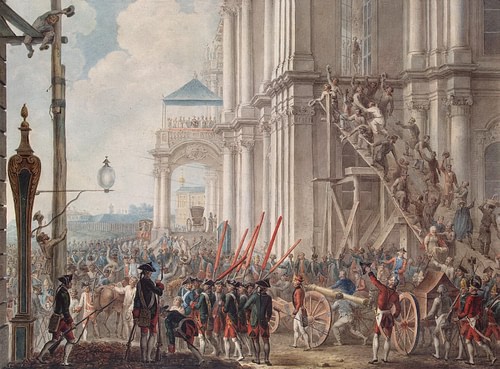
On 28 June 1762, Catherine seized power and was proclaimed Russian empress by the Russian army. Peter was arrested and forced to sign abdication papers. Shortly afterwards, Peter was killed, most likely by Grigory's brother, Alexei Orlov (1737-1808). There has been speculation about Catherine's role in his death, but there is no concrete evidence to prove her involvement.
Coronation
Catherine was formally crowned empress regent on 22 September 1762 at the Assumption Cathedral in Moscow as Catherine II of Russia. The Imperial Crown of Russia was made for her coronation and became the coronation crown for the Russian sovereigns from that point forward. It comprised 75 pearls, a diamond cross, a ruby, and 4,936 Indian diamonds, and gold and silver half spheres representing the eastern and western Russian empires. It was designed by Jérémie Pauzié (1716-1779), a Swiss-French court diamond jeweller.
By being crowned empress regent, Catherine followed in the footsteps of Catherine I of Russia (1684-1727), who came from a lower-class family, married Peter I (Peter the Great) (1672-1725) and then became empress regent in 1725 with the support of the Russian army.
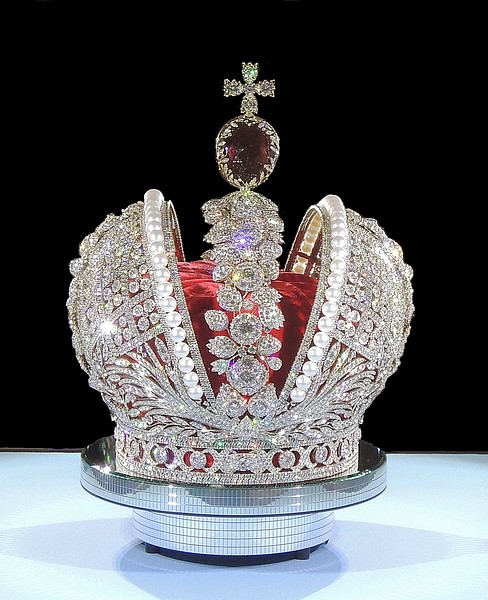
Reformation of Legal & Administration Systems
In 1775, the Statute for the Administration of the Provinces of the Russian Empire was published. Its guidelines included setting up individual institutions for the administration, justice, and finance systems. The administration was to be under the control of a governor who was assisted by a deputy governor who would collect taxes and dues.
Under the governor, law courts were established with an upper, a lower, and a district court for the upper, middle, and lower classes. The statute also set out instructions on the general care and well-being of the Russian people, with boards of social welfare formed under the governor in each provincial capital. The social welfare board oversaw hospitals, workhouses, almshouses, and houses of correction.
Educational Reforms
One of the most important focuses of Catherine's reign was the educational system in Russia. She believed that all Russian children should be getting a European education and was passionate about both males and females getting a proper education. She appointed Ivan Betskoy (c. 1704) as her educational advisor. He studied the educational system in Russia compared to other countries. Catherine established an educational commission and met with other educational pioneers, including Reverand Daniel Dumaresq (1712-1805), who joined her educational commission.
She established the Smolny Institute for Noble Girls, which educated wealthy and noble females, later accepting girls from middle-class families. She also transformed the Cadet Corps in 1766, which educated children from a young age until they were 21. History, philosophy, the arts and science were added to the curriculum. In 1786, the Russian Statute of National Education was created, which established a two-tier system of primary and high schools that were free for children of all classes, with the exception of the serfs. The Statute regulated the curriculum and trained teachers.
There were many critiques aimed at Catherine's educational reforms, with her critics claiming that she failed to provide enough money towards the educational system, and nobles still preferred to send their children to private, expensive schools instead of state institutions. She also prevented many peasants from becoming educated.
Serfs & Pugachev's Rebellion
The serfs were peasants who gave up their freedom and worked for landowners so they could be protected during challenging times. Catherine inherited Russia's serf system. However, she made some changes and improvements. She prohibited former serfs from being able to become serfs again, and she set up a formal bureaucratic status, which meant they could apply for freedom if they were illegally owned. She also allowed serfs to make complaints against their landowners to prevent any revolts.
However, it is clear that although Catherine made some improvements for the serfs, she was not entirely of a modern mindset regarding their well-being and freedom. She abolished an act put in place by Peter the Great, which freed all serfs that belonged to the Russian Orthodox Church.
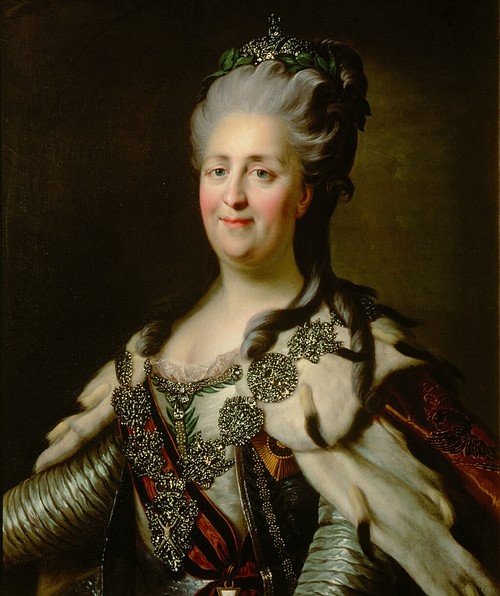
In 1771, there was a widespread crop failure which further limited the freedom of the serfs. This resulted in violence and protests, which led to Pugachev's Rebellion (1773-1775). Yemelyan Pugachev (1742-1775) was an ex-lieutenant of the Russian Imperial Army. He became the leader of an alternative Russian government in the name of Peter III. He claimed that he should become emperor of Russia. He advocated for the freedom of serfs and helped the lower class, who rallied by his side in support. Pugachev's Rebellion was the largest peasant rebellion in Russian history and was only completely quashed when Pugachev was arrested and executed in January 1775.
War & International Relations
Russia was victorious during the First Russo-Turkish War (1768-1774), which saw the Russian Empire's borders being expanded into modern-day south Ukraine and the Black Sea. Catherine annexed Crimea, which became part of Russia after the Second Russo-Turkish War (1787-1792). In 1791, Russia and Prussia formally signed a truce.
From 1788-1790, Catherine and Russia engaged in a war against Sweden and Catherine's cousin King Gustav III of Sweden (1746-1792). In 1789, the Swedish Navy overpowered the Russian Navy, forcing the Russians to negotiate. This led to the signing of the Treaty of Värälä in 1790, which saw all captured land being returned to their original owners.
In 1791, the May Constitution sought to establish a more democratic monarchy in the Polish-Lithuanian Commonwealth. This constitution gave peasants government protection and ensured political equality between the nobles and lower classes. Catherine decided to intervene. A ceasefire was met after three months, with Russia being able to partition parts of Poland between Prussia and Austria. In 1796, Russia went to war against Persia after signing the Treaty of Georgievsk, where Russia swore to protect Georgia against a Persian invasion. Catherine would die before the battle ended.
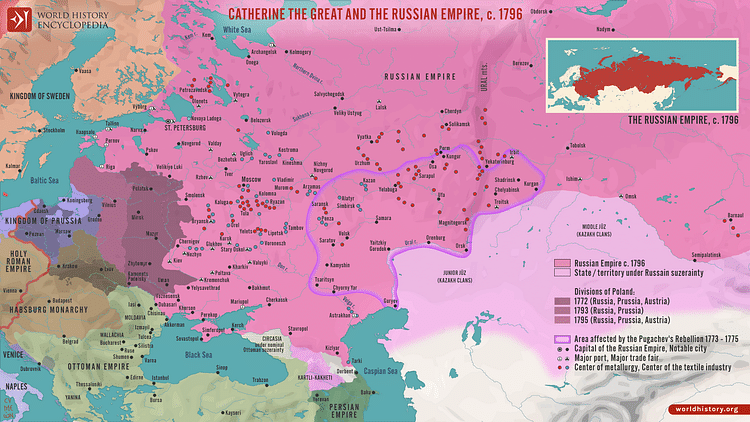
Although Catherine did involve Russia in several wars, she was also a firm believer in peace and diplomacy, and under her rule, Russia became an international mediator, with Russia mediating the War of the Bavarian Succession (1778-1779) between Prussia and Austria. Catherine also established the League of Armed Neutrality in 1780, which protected the shipping by neutral interests from the British Royal Navy during the American Revolution (1775-1783). In 1792, Catherine sought to establish trade relations with Japan and sent a trade mission. The negotiations ultimately failed to go any further.
Patroness of the Arts
Catherine was passionate about the arts, taking a particular interest in literature, painting and philosophy, and even dabbled in writing her own comedies and fiction. She was highly praised by the French writer Voltaire (1694-1778) and the French philosopher Diderot (1713-1784). During her rule, she founded the Hermitage Museum in St. Petersburg, which remains the second-largest art museum in the world. On 7 December, the museum celebrates its founding as Saint Catherine's Day. Catherine's reign saw the birth of the Russian intelligentsia in which more people travelled, spoke foreign languages, attended university, wrote plays, poetry, and novels, and translated written works into Russian.
Religion
Catherine nationalised all church land to pay for wars. During her reign, nobles became more important than the church itself. However, she introduced a policy that protected Christians during Turkish rule and promoted the conversion to Russian Orthodoxy.
In 1767, the Legislative Commission of 1767 was introduced, which protected the religious rights of Muslims. This was further extended with the Toleration of Faiths Edict in 1773, which allowed Muslims to build mosques and practise their faith. Catherine treated Judaism as a separate legal system, but she began to assimilate the Jewish people with the Charter of the Towns Act in 1782, in which they were recognised as equals to Russian Orthodox citizens.
In 1786, Catherine called for religion to be excluded from the state schools. Her personal view towards religion could be seen as secularism.
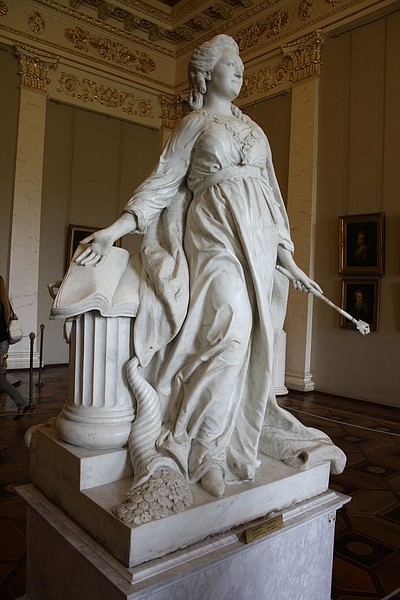
Death & Legacy
Catherine died at the age of 67 on 17 November 1796 after suffering from a suspected stroke. Catherine's legacy as 'Catherine the Great' endures to this day. She was exceptionally well-educated and brought many of her enlightened ideas to fruition during her long reign. Visitors to the imperial court all commented on Catherine's grace and kindness and the dignity she presented herself with. She sought to bring Russia into the modern world and largely succeeded in doing that.
She has inspired many books, paintings, films and operas, with the most famous today being the 2019 TV series Catherine the Great, in which renowned English actress Dame Helen Mirren plays Catherine and the popular TV series The Great (2020-), where Catherine is played by the American actress Elle Fanning.



